#African Blackfoot Penguin
Explore tagged Tumblr posts
Text



New Releases
All of these books look interesting to me. I don't even know which book I want to add to my TBR reading list first.
Gita Desai Is Not Here to Shut Up by Sonia Patel Penguin/Nancy Paulsen Books
It’s eighteen-year-old Gita Desai’s first year at Stanford University, and it’s a miracle she’s here and not already married off by her traditional Gujarati parents. She’s determined to death-grip her good-girl, model-student rep all the way to medical school, which means no social life or standing out in any way. Should be easy: If there’s one thing she’s learned from her family it’s how to chup-re—to “shut up,” fade into the background.
But when childhood memories of her aunt’s desertion and her then-uncle’s best friend resurface, Gita ditches the books night after night in favor of partying and hooking up with strangers. Still, nothing can stop the nagging voice in her head that’s growing louder and louder, insisting something’s wrong… and the only way she can burst forward is to stop shutting-up about the past.
Click below to read about all of this week's new releases.
Ida, in Love and in Trouble by Veronica Chambers Little, Brown Books for Young Readers
Before she became a warrior, Ida B. Wells was an incomparable flirt with a quick wit and a dream of becoming a renowned writer. The first child of newly freed parents who thrived in a community that pulsated with hope and possibility after the Civil War, Ida had a big heart, big ambitions, and even bigger questions: How to be a good big sister when her beloved parents perish in a yellow fever epidemic? How to launch her career as a teacher? How to make and keep friends in a society that seems to have no place for a woman who speaks her own mind? And – always top of mind for Ida – how to find a love that will let her be the woman she dreams of becoming?
Ahead of her time by decades, Ida B. Wells pioneered the field of investigative journalism with her powerful reporting on violence against African Americans. Her name became synonymous with courage and an unflinching demand for racial and gender equality. But there were so many facets to Ida Bell and critically acclaimed writer Veronica Chamber unspools her full and colorful life as Ida comes of age in the rapidly changing South, filled with lavish society dances and parties, swoon-worthy gentleman callers, and a world ripe for the taking.
Till the Last Beat of My Heart by Louangie Bou-Montes HarperCollins
When you grow up in a funeral home, death is just another part of life. But for sixteen-year-old Jaxon Santiago-Noble, it’s also part of his family’s legacy. Most dead bodies in the town of Jacob’s Barrow wind up at Jaxon’s house; his mom is the local mortician, after all. He doesn’t usually pay them much mind, but when Christian Reyes is brought in after a car accident, Jaxon’s world is turned upside down.
There are a lot of things Jaxon wishes he could have said to his once best friend and first crush. When he accidentally resurrects Christian, Jaxon might finally have that chance. But the more he learns about his newfound necromancy, the more he grasps that Christian’s running on borrowed time—and it’s almost out.
As he navigates dark, mysterious magics and family secrets, Jaxon realizes that stepping into an inherited power may also mean opening up old family wounds if he wants to keep the boy he may be falling for alive for good.
The Rez Doctor written by Gitz Crazyboy & illustrated by Veronika Barinova HighWater Press
Young Ryan Fox gets good grades, but he’s not sure what he wants to be when he grows up. It isn’t until he meets a Blackfoot doctor during a school assembly that he starts to dream big.
However, becoming a doctor isn’t easy. University takes Ryan away from his family and the Siksikaitsitapi community, and without their support, he begins to struggle. Faced with more stress than he’s ever experienced, he turns to partying. Distracted from his responsibilities, his grades start to slip. His bills pile up. Getting into med school feels impossible. And now his beloved uncle is in jail. Can Ryan regain his footing to walk the path he saw so clearly as a boy?
Desert Echoes by Abdi Nazemian HarperCollins
From Abdi Nazemian, the award-winning author of Like a Love Story and Only This Beautiful Moment, comes a suspenseful contemporary YA novel about loss and love.
Fifteen-year-old Kam is head over heels for Ash, the boy who swept him off his feet. But his family and best friend, Bodie, are worried. Something seems off about Ash. He also has a habit of disappearing, at times for days. When Ash asks Kam to join him on a trip to Joshua Tree, the two of them walk off into the sunset . . . but only Kam returns.
Two years later, Kam is still left with a hole in his heart and too many unanswered questions. So it feels like fate when a school trip takes him back to Joshua Tree. On the trip, Kam wants to find closure about what happened to Ash but instead finds himself in danger of facing a similar fate. In the desert, Kam must reckon with the truth of his past relationship—and the possibility of opening himself up to love once again.
Desert Echoes is a propulsive, moving story about human resilience and connection.
Between the Pipes Story by Albert McLeod with Elaine Mordoch and Sonya Ballantyne (Contributor) & illustrated by Alice RL HighWater Press
Thirteen-year-old Chase’s life and identity should be simple. He’s the goalie for his hockey team, the Eagles. He’s a friend to Kevin and Jade. He’s Kookum’s youngest grandchild. He’s a boy. He should like girls.
But it’s not that simple. Chase doesn’t like girls the way that the other boys do. It’s scary being so different from his peers. Scarier still is the feeling that his teammates can tell who he is—and that they hate him for it. If he pretends hard enough, maybe he can hide the truth.
Real strength and change can’t come from a place of shame. Chase’s dreams are troubled by visions of a bear spirit, and the more he tries to hide, the more everything falls apart. With the help of an Elder, and a Two-Spirit mentor, can Chase find the strength to be proud of who he is?
“Between the Pipes” explores toxic masculinity in hockey through the experiences of an Indigenous teen.
They Thought They Buried Us by NoNieqa Ramos Carolrhoda Lab
Horror fan and aspiring film director Yuiza gets a scholarship to a prestigious boarding school. But that’s just the tip of the iceberg.
As one of the few students of color at Our Lady of Perpetual Mercy, Yuiza immediately feels out of place. A brutal work-study schedule makes it impossible to keep up with the actual classes. Every expense, from textbooks to laundry, puts Yuiza into debt. And the behavior of students and faculty is… unsettling.
Yuiza starts having disturbing dreams about the school’s past and discovers clues about the fate of other scholarship students. It’ll take all Yuiza’s knowledge of the horror genre to escape from Our Lady’s grasp.
How to Lose a Best Friend by Jordan K. Casomar MTV Books
For as long as anyone can remember, Zeke Ladoja and Imogen Parker have been best friends. Their classmates, their parents, and even the school custodian think that they’re meant to be together. And that’s exactly what Zeke wants: for Gen to be his girlfriend. Now that she’s about to be sixteen (and allowed to date), Zeke is finally going to tell her how he feels—in front of everyone at her birthday party.
Imogen loves Zeke with all her heart, but only as a friend. The pressure to be with Zeke has sometimes been overwhelming, but up to this point, she’s been able to manage it. Then she falls for the new boy, Trevor Cook, and she knows the news will devastate Zeke. The last thing she wants to do is hurt her best friend, but she also resents the fact that no one seems to care about what she wants.
The night of Gen’s party, everything goes wrong. There’s backlash, most of it directed at Gen, and Zeke feels emboldened. He isn’t about to give up on his feelings, and he’ll do whatever it takes to prove that she made the wrong choice…even if it means destroying their friendship. But Gen isn’t about to give up on fighting for herself and the freedom to love the boy she wants, not the boy she’s expected to be with.
16 notes
·
View notes
Note
This is a free coupon/excuse for you to infodump on the current topic you’re obsessed with. Take some time away from internet discourse and share with us something you find interesting.
Ohohohohohohoho, anon, mistakes have been made. X,D
I would like to introduce you to these idiots that I love more than anything:

Say hi to Randi and Green Bean! These guys are African Blackfoot Penguins (Spheniscus demersus) and are the only penguin species found on the continent of Africa!

The orange that you see is their natural range. These penguins live in large colonies along the rocky coastlines, where they sleep at night. During the day, they spend most of their time out at sea looking for food. Penguins in general eat a shittonne of fish-- they can eat up to fourteen percent of their entire bodyweight! Depending on the time of year, of course. Food demands will rise and fall depending on things like breeding season and whether or not it's time for them to molt. What do they eat? Fish! Anchovies are a favorite, as are round herring, and they even can eat crustaceans like krill or squid.
These penguins are considered medium sized, falling around 1.5 feet tall and nearly seven pounds on average. They're also within a group of penguins affectionately referred to as "banded" penguins, do to the thick black band that runs along their sides and chest. Their "tuxedo" pattern that all penguins are famous for actually serves a purpose-- it's a type of camouflage called countershading. Basically, the pale belly helps these birds blend in with the light shining into the water from above and helps shield them from any predators lurking down below, and the dark back helps them blend into the darker depths down below, protecting them from any possible predators lurking from above.
What preys on penguins, you ask? Quite a few things! General predators for various species can include sharks, seals, or killer whales, but the Blackfoots can also fall prey to large birds of prey and land predators, such as dogs and cats.
African Blackfoot Penguins are also a highly social species-- as I mentioned above, they live in large colonies along the beaches, and in those colonies, they pick mates and establish a social hierarchy, communicating through a variety of calls. These birds display three types of calls; the bray, the yell, and the haw. Their most famous call, the bray, is used to attract a mate or between partners displaying to each other in a colony, and sounds shockingly similar to a donkey's bray, which is where they earn their other common name: The Jackass Penguin. The yell is a call they use when warding off or "yelling" at a rival colony member, most likely from encroaching on their nesting site or favorite corner. The last call, the haw, is used between partners, usually when one is out in the water and the other is on land.
These birds are considered monogamous, which means they will return to the same partner for multiple breeding seasons, sometimes even staying with the same partner their entire lives. (This isn't always the case, however. Penguins absolutely do cheat or "divorce", though how common that is varies from species to species and individual to individual). Each colony will return to the same breeding and nesting sites year after year, and while breeding can occur year-round, it reaches a peak in South Africa in March-May. African penguins are "burrowers", and will dig a shallow burrow in the earth, often under rocks or vegetation in an effort to escape the heat.
Females lay two eggs, which usually take around 40 days to hatch. Both partners will take turns incubating the eggs and protecting the nest from predators and colony members alike-- as kidnappings and nest raids are a common occurrence among penguins. The parents feed their young by regurgitating food into their mouth, and after about a month, they begin to leave their young with the other colony kids in large groups while they forage during the day. Baby Blackfoots ditch their down between 2-4 months, which they trade for their "juvenile" plumage, which looks very different than a mature Blackfoot's plumage.

They keep this look for their first year, usually swapping to their adult plumage after their second year molt.
These penguins are also endangered! According to the Red List, there is currently 41,700 mature individuals left in the wild and their numbers are declining. There's a myriad of reasons for that and most of them point to human interaction; feral cats and dogs, human encroachment, pollution (especially oil spills), and one of the worst offenders, competition with commercial fishing over their food. Fisheries in the seas near their home are in major decline and that's forcing penguins to have to swim farther and longer to find enough food for themselves and their offspring.
Ironically, what ripped the carpet from under these guys, so to speak, is their shit. See, once upon a time, many of the islands that made up the breeding grounds for the Blackfoots were piled high with something called guano, also known as penguin shit. Years and years of breeding there had made this shit accumulate, and this guano made up a perfect substrate for the Blackfoots to burrow into to build their nests and escape the brutal African summer heat and sun. The problem, is when humans showed up. See, guano, like lots of other animal shit, makes a fantastic fertilizer. And as global trade was increasing and people from Europe were travelling and exploring, these islands of guano got discovered. And raided. Humans came in and quite literally dug up all the penguin shit they could, leaving hardly anything behind for these birds to burrow in, and as a direct result, their population plummeted.
Nowadays, we've been helping these guys out by making artificial nests to help keep them cool and protected, and it's been working! But the population overall is still in a massive decline.
Now, if you want to help there's many organizations out there helping the birds. Like SANCCOB , SAFE , etc. Also supporting sustainability, cleaner energy, and wild-life friendly policies are great ways to help penguins and other animals.
Now. There you have it. My ridiculous infodump on African Penguins. You're welcome, nonnie 🤣 Say hi to Blueberry, and have a lovely evening, lmaoo
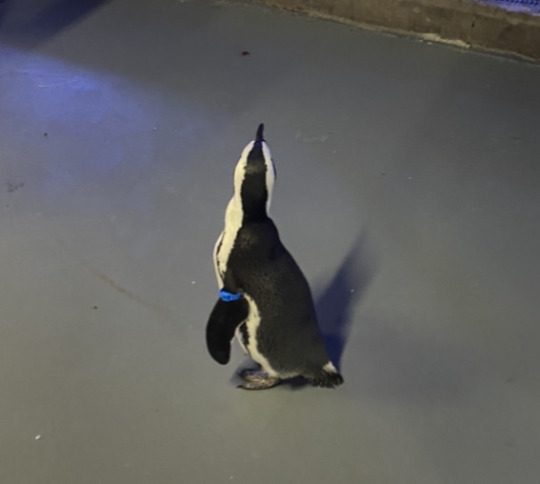
#ask me anything#kat rambles#adventures in biology#adventures in science#penguins#Spheniscus demersus#African Blackfoot Penguin
101 notes
·
View notes
Text

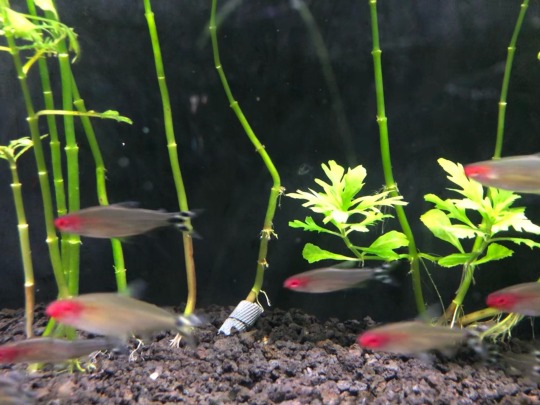
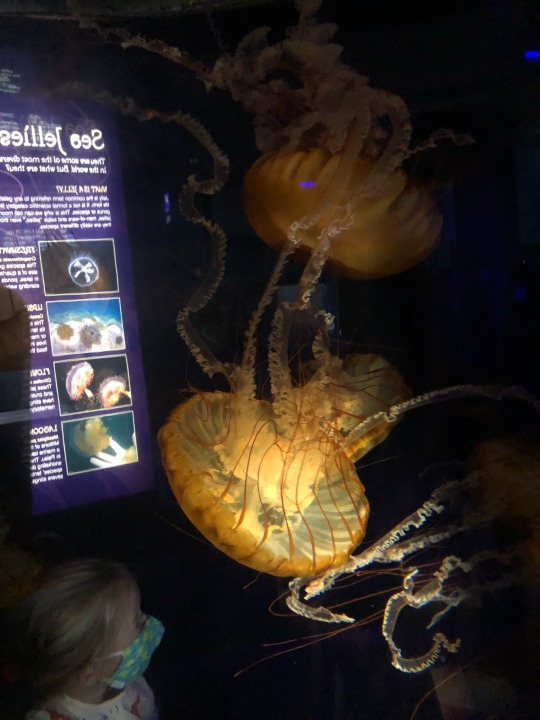

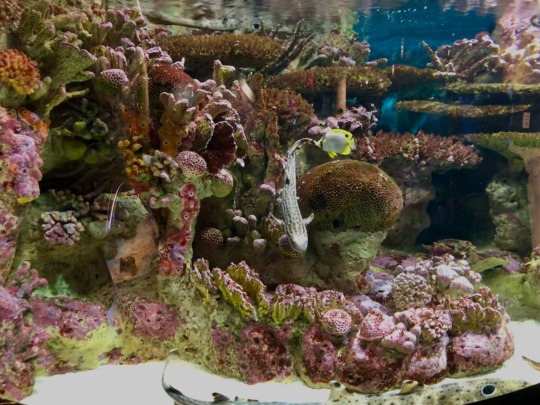
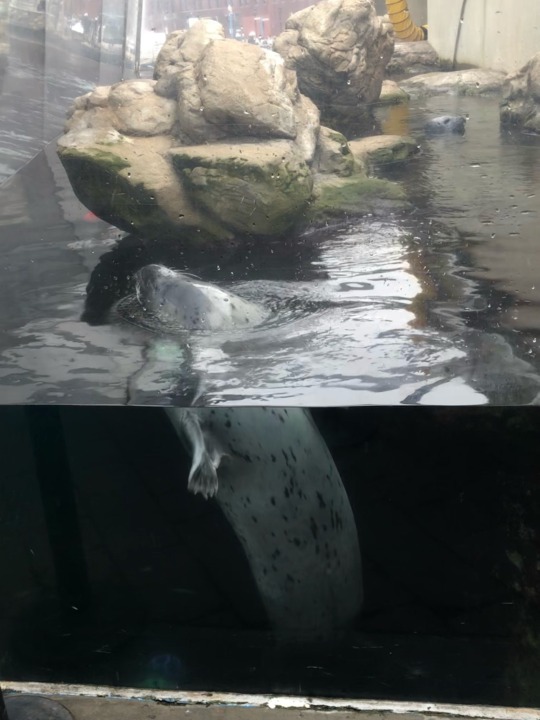
New England Aquarium
#giant pacific octopus#african blackfooted penguins#seals#jellyfish#tetras#aquarium#photography#aquatic#new england aquarium
11 notes
·
View notes
Text
im going to the aquarium tomorrow and i cannot fucking WAIT to see the beluga whales!!!!!
1 note
·
View note
Photo

We have two new juvenile South African blackfoot penguins. Until they’re adults young penguins are referred to as “blues.” We have two new males. Jake and Elwood! The Blues Penguins LOL! I mean it only makes sense, the Blue Brothers had to go and help “The Penguin.”
3 notes
·
View notes
Note
what animal do you know the most about, and where did you learn about it from?
i know lots of fun facts about lots of marine pals because i work at the aquarium!!
(including but not limited to: sea otters, african blackfooted penguins, green sea turtles, gulf coast box turtles, etc etc)
1 note
·
View note
Photo

Penguin, probably a South African blackfoot, aka jackass penguin for their donkey-like brayings. Definitely spheniscus genus, anyway. Looking like a deep thinker which, trust me, they’re not. Still cool birds to work with though!
0 notes
Video
youtube
How to draw a penguin-draw a realistic penguin-draw a penguin step by step easy. Penguins are intriguing fowls. Despite the fact that they can't fly, they astound us as they slug through water at rocket speed, speedier than any human swimmer. Music source: http://www.bensound.com/royalty-free-music Social Media https://plus.google.com/u/0/106296181955452800866 https://twitter.com/HowtoDraw20 https://www.instagram.com/asmarbd.m/ https://www.tumblr.com/blog/luckycollectlove http://cowhata.blogspot.com/ They have eating methodologies of fish, and can do everything different flying creatures do with the exception of fly. Penguins live in various spots. We regularly observe motion pictures of penguins that live in Antarctica, and generally believe that penguins just live in the Antarctic. When we see motion pictures of the African deserts, we some of the time imagine that a penguin will most likely be unable to live in Africa. Yet, we are incorrect. There are really penguins that live in Africa, close to the Kalahari and Namib Deserts. In any case, our wrong musings that there are no penguins in Africa may be right soon. The African Penguin is profoundly jeopardized. The populace drops always, for some reasons. Here are ways the African Penguin is debilitated, and how we can spare this flying creature in require. The number of inhabitants in African Penguins was "more than one million people in the start of the earlier century (1)". "By 1956, the populace was half of that sum. The populace dropped to half of that sum in the 1970's. At that point, there was around 220,000 people. By the 1980's that number was 194,000. By the 1990's the populace was around 179,000. The populace was concentrated to drop 2% every year (2)". "By 2010, the populace was tallied to be around 55,000 people around the world, and is required to go wiped out in 15 years if the populace drop is not halted (3)". How do people posture dangers to the African Penguin? Dangers incorporate contamination and angling. This might be a little measure of issues, yet they occur on a huge premise, and genuinely influence the penguin populace. One time, an oil tanker had a spill off the bank of South Africa, and several penguins were influenced by the oil slick. This turned into "the biggest creature safeguard occasion ever, on the grounds that over 91% of the penguins were discharged once more into the wild (3)". This unquestionably helped the populace, in light of the fact that on the off chance that it had not happened, the fowl might be terminated at this point. The penguin additionally confronts common dangers, from creatures, for example, "seals, sharks, whales, mongooses, and ocean gulls (3)". The narrative Penguins Under Siege: The True Story of South Africa's Blackfoot Penguins discusses two African Penguins attempting to survive common predators. Its trailer specified that "seals are determined seekers (4)" and will never stop with regards to a penguin pursue. It likewise said gulls dependably sit tight for a penguin to leave its home so it can "take its eggs (3)". Tragically, the penguin's flightlessness is a powerlessness. In the event that it could fly, it could have a superior escape or, now and then, have the capacity to battle back. In any case, there is very little we can do about that. This reduction in penguins likewise happens on an expansive premise.
0 notes
Note
I volunteered at my local zoo in 2015 and had the fabulous luck to spend most of that time with their African Blackfooted Penguins. I absolutely love those little knee-high(ish) beasties, but I was seriously considering buying shin guards because of how much they pecked my shins with their pointy-tipped beaks and it hurt. At a non-U.S. zoo an Emperor penguin (IIRC) earned himself the name Vlad the Impaler when he throat-pecked a keeper. I don’t remember what, if anything, was the provocation.
I’ve also been bitten. I was assisting one of the keepers with re-banding one of the penguins--the bands are cut-down zipties around the top of the wing, like a bracelet, with colored beads on them in a pattern specific to that bird--and the penguin Did Not appreciate being held while its wing was being futz with. My finger was the closest thing it could clamp its beak onto. Yeah, that hurt. >.< *shrugs* These things, they do happen.
A penguin bit you?! Did it happen at a zoo or aquarium? Well I mean, obviously it did unless you live in Antarctica or something lol. My grandmother was missing half her left ass cheek because a monkey bit it off after she mooned it when she was teenager.
When I was 3 or 4 my brother and I got to go behind the scenes at the SF zoo. I fed a giraffe, pet a lion, and held a baby penguin. Which prompted the mother to come over and peck my shoulder. I recall crying and a lot of blood. 35 years later I have an old, shiny, white scar on my shoulder that’s a hell of a story.
10 notes
·
View notes
Video
tumblr
Greetings friends and welcome to this week?s blog post. Before we get started with our topic on penguins, I want to remind you all that we still have a "Name The Baby Owl Monkey" contest running. You can click the pinned post on our Facebook page for details. Now onto our next topic, Jake and Elwood. Timbavati Wildlife Park is now home to two South African Blackfoot penguins. We all know and love Mama and Papa our long time penguin pair. This summer they were joined by Jake and Elwood. Now why the names Jake and Elwood? Our owner Alice Schoebel explained to me that juvenile penguins are referred to as ?blues? because their feathers have a blue tint and they aren?t black and white in color yet. Apparently she shared this bit of useful knowledge with one our guests and this prompted him to ask ?Are both of them boys?? When Alice told them ?yes? this guy immediately called them the ?Blues Brothers? without hesitation. Boom from that moment on they were called Jake and Elwood. A lot of animals around Timbavati Wildlife Park have cute stories about their names. Some are attributed to personality, some are attributed to color and some of them are even named by you. Make sure you like our pages for interesting tidbits about our animals and notifications about specials that we are running. Thanks and we?ll see you in the park.
2 notes
·
View notes
Note
Hi! As far as I am aware, The Blackfoot African Penguin is the only penguin unique to Africa. They live there and breed there.
Southern Rockhopper penguins live among subarctic islands, between 46 and 54 degrees South latitude, like the Falkland Islands. They do return to the same breeding sites every year, but I’m not seeing anything about this species having nesting sites in Africa. All the information I’m seeing lists their nesting sites along South AMERICA and Islands in the South Indian Ocean.
Here’s a pic of the Southern Rockhopper’s range:

And a range map for all penguin species. There does appear to be two islands along a similar latitude to South Africa where some populations are found, but as you can see Africa itself is devoid of Rockhoppers. What the climate of these islands are, I don’t know, but typically this species is considered “cold weather” or adapted to cooler climates. (color coded, hot pink for Southern Rockhoppers. Apologies, I’m adding this from my phone):

This is a free coupon/excuse for you to infodump on the current topic you’re obsessed with. Take some time away from internet discourse and share with us something you find interesting.
Ohohohohohohoho, anon, mistakes have been made. X,D
I would like to introduce you to these idiots that I love more than anything:

Say hi to Randi and Green Bean! These guys are African Blackfoot Penguins (Spheniscus demersus) and are the only penguin species found on the continent of Africa!

The orange that you see is their natural range. These penguins live in large colonies along the rocky coastlines, where they sleep at night. During the day, they spend most of their time out at sea looking for food. Penguins in general eat a shittonne of fish-- they can eat up to fourteen percent of their entire bodyweight! Depending on the time of year, of course. Food demands will rise and fall depending on things like breeding season and whether or not it's time for them to molt. What do they eat? Fish! Anchovies are a favorite, as are round herring, and they even can eat crustaceans like krill or squid.
These penguins are considered medium sized, falling around 1.5 feet tall and nearly seven pounds on average. They're also within a group of penguins affectionately referred to as "banded" penguins, do to the thick black band that runs along their sides and chest. Their "tuxedo" pattern that all penguins are famous for actually serves a purpose-- it's a type of camouflage called countershading. Basically, the pale belly helps these birds blend in with the light shining into the water from above and helps shield them from any predators lurking down below, and the dark back helps them blend into the darker depths down below, protecting them from any possible predators lurking from above.
What preys on penguins, you ask? Quite a few things! General predators for various species can include sharks, seals, or killer whales, but the Blackfoots can also fall prey to large birds of prey and land predators, such as dogs and cats.
African Blackfoot Penguins are also a highly social species-- as I mentioned above, they live in large colonies along the beaches, and in those colonies, they pick mates and establish a social hierarchy, communicating through a variety of calls. These birds display three types of calls; the bray, the yell, and the haw. Their most famous call, the bray, is used to attract a mate or between partners displaying to each other in a colony, and sounds shockingly similar to a donkey's bray, which is where they earn their other common name: The Jackass Penguin. The yell is a call they use when warding off or "yelling" at a rival colony member, most likely from encroaching on their nesting site or favorite corner. The last call, the haw, is used between partners, usually when one is out in the water and the other is on land.
These birds are considered monogamous, which means they will return to the same partner for multiple breeding seasons, sometimes even staying with the same partner their entire lives. (This isn't always the case, however. Penguins absolutely do cheat or "divorce", though how common that is varies from species to species and individual to individual). Each colony will return to the same breeding and nesting sites year after year, and while breeding can occur year-round, it reaches a peak in South Africa in March-May. African penguins are "burrowers", and will dig a shallow burrow in the earth, often under rocks or vegetation in an effort to escape the heat.
Females lay two eggs, which usually take around 40 days to hatch. Both partners will take turns incubating the eggs and protecting the nest from predators and colony members alike-- as kidnappings and nest raids are a common occurrence among penguins. The parents feed their young by regurgitating food into their mouth, and after about a month, they begin to leave their young with the other colony kids in large groups while they forage during the day. Baby Blackfoots ditch their down between 2-4 months, which they trade for their "juvenile" plumage, which looks very different than a mature Blackfoot's plumage.

They keep this look for their first year, usually swapping to their adult plumage after their second year molt.
These penguins are also endangered! According to the Red List, there is currently 41,700 mature individuals left in the wild and their numbers are declining. There's a myriad of reasons for that and most of them point to human interaction; feral cats and dogs, human encroachment, pollution (especially oil spills), and one of the worst offenders, competition with commercial fishing over their food. Fisheries in the seas near their home are in major decline and that's forcing penguins to have to swim farther and longer to find enough food for themselves and their offspring.
Ironically, what ripped the carpet from under these guys, so to speak, is their shit. See, once upon a time, many of the islands that made up the breeding grounds for the Blackfoots were piled high with something called guano, also known as penguin shit. Years and years of breeding there had made this shit accumulate, and this guano made up a perfect substrate for the Blackfoots to burrow into to build their nests and escape the brutal African summer heat and sun. The problem, is when humans showed up. See, guano, like lots of other animal shit, makes a fantastic fertilizer. And as global trade was increasing and people from Europe were travelling and exploring, these islands of guano got discovered. And raided. Humans came in and quite literally dug up all the penguin shit they could, leaving hardly anything behind for these birds to burrow in, and as a direct result, their population plummeted.
Nowadays, we've been helping these guys out by making artificial nests to help keep them cool and protected, and it's been working! But the population overall is still in a massive decline.
Now, if you want to help there's many organizations out there helping the birds. Like SANCCOB , SAFE , etc. Also supporting sustainability, cleaner energy, and wild-life friendly policies are great ways to help penguins and other animals.
Now. There you have it. My ridiculous infodump on African Penguins. You're welcome, nonnie 🤣 Say hi to Blueberry, and have a lovely evening, lmaoo

#adventures in biology#I do work with two of these guys#they’re doofuses but definitely like the cold#though cold is like#40 degrees#subarctic not Arctic after all lol#adventures in science
101 notes
·
View notes